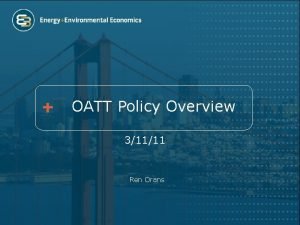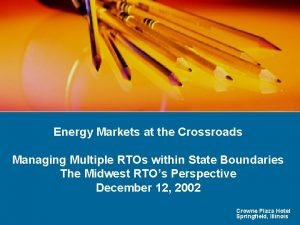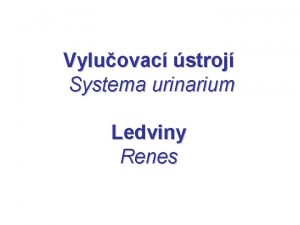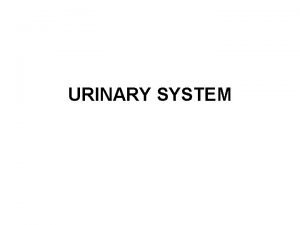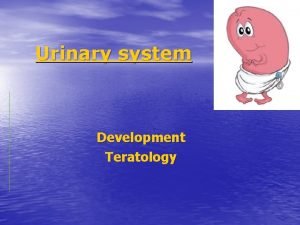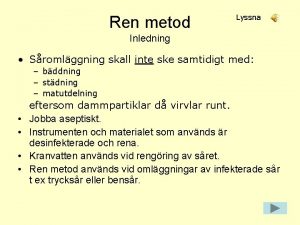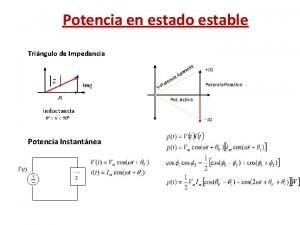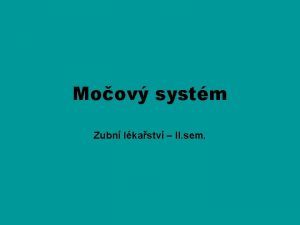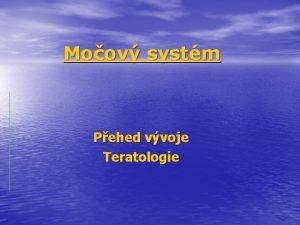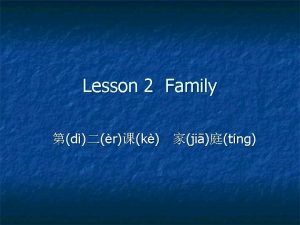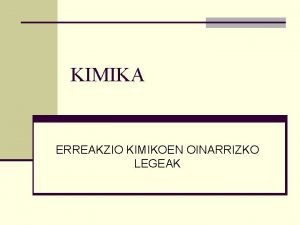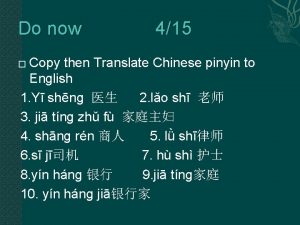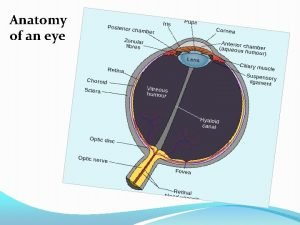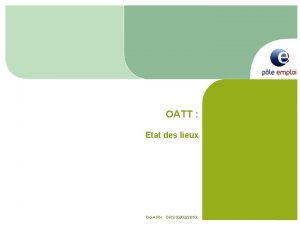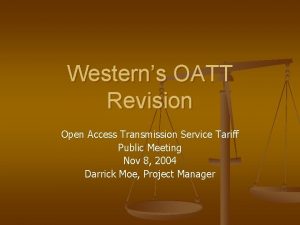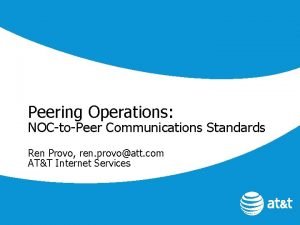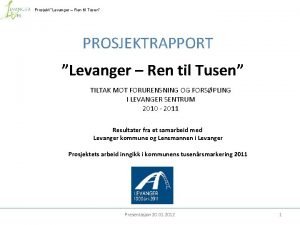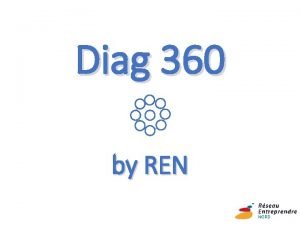OATT Policy Overview 31111 Ren Orans Agenda History



















- Slides: 19

OATT Policy Overview 3/11/11 Ren Orans

Agenda History of the FERC pro forma Open Access Transmission Tariff (OATT) and its use in British Columbia Evolving North American Industry Standards Access to Transmission under the OATT 2

HISTORY OF OATT AND USE IN BC

Policy goals of FERC A primary FERC policy objective is to encourage broad, competitive generation markets • The tools FERC can use to drive its policy goals arise from its jurisdiction under section 201(b)(1) of the Federal Power Act • Transmission of electricity in interstate commerce; and • Sale of electricity at wholesale in interstate commerce. Since mid-1990 s, FERC has driven much of its policy agenda through a pro forma transmission tariff, beginning with Order 888. Subsequent orders have modified the pro forma tariff, spoken to market structures (such as RTOs), and defined flexibility both inside RTOs and in regions without RTOs. 4

FERC Order 888 (1996) Purpose: To open wholesale electric market competition Order 888 set out a detailed pro forma open access transmission tariff (OATT) Requires all public utilities to file an OATT that provides competitors the same services, on the same terms and conditions, as utilities provide to themselves and to their affiliates. Allows third parties access to the transmission system without requiring utilities to separate transmission, generation, and marketing functions – no need for restructuring & divesting Does not require direct retail access Continues to provide certain advantages to domestic load service – flexible network secondary rights, for example. Contains reciprocity provisions Both OATT and SOC were created as companion orders and have evolved over time 5

FERC Landmark Orders – Beyond 888 Order 888/889 1996 Requires all utilities to file an open access transmission tariff (OATT) that provides competitors the same transmission services it provides itself. SOC was introduced here too. RESULT: Opened wholesale electricity market. Order 2000 Required public utilities that own transmission to join pools and RTOs. RESULT: South/West U. S. complain and Congress sustains that utilities are not required to join RTOs. FERC is left with some pools and the rest using 888 -type OATTs. Order 2003 Sets standard procedure that must be followed by all interconnection customers and transmission providers. Includes cost and responsibility allocation, rights, and dispute resolution processes. RESULT: All costs associated with interconnection facilities before the point of interconnection assigned to the interconnection customer. Facilities beyond the point of interconnection are considered “network upgrades” and are paid for by the customer and refunded through transmission credits. Order 2004 Order 890 Order 717 2003 20072008 Revised standards of conduct for transmission. Reforms a number of providers and their elements of Order 888 to associated energy further enforce affiliates. It required comparability and undue transmission function discrimination. employees to work independently of RESULT: Creates tiered sales/marketing imbalance charges and a employees conditional firm service. Also, FERC moves away RESULT: Required from corporate functional separation approach separation 6

OATT has Tracked Evolution of FERC Policy FERC has continuously amended the OATT to follow changing policy goals, to make the tariff more practical, to track jurisdictional definition by the courts, and to follow industry evolution • Flexible approach to RTOs and non-RTO regions • Modified OATT to address issues that arise with undue discrimination (e. g. Order 890) FERC has also relaxed its requirement for strict adherence to the pro forma • Allows for regional or circumstantial differences, e. g. allows matters such as opportunity cost to be defined on a “case-by-case” basis if needed • Provides wide latitude for business practice flexibility 7

Functional Unbundling Example Vertically Integrated Generation Transmission Distribution Retail Service Customer Heritage Utility Generation Separation of Transmission System Independent Power Producers Transmission Distribution Wholesale Customer FERC Standard 888 OATT Standards of Conduct Divestiture of generation 8

Adoption of the OATT in BC BC Hydro introduced a FERC Order 888 pro forma OATT in the mid-1990 s • Primary motivation was to ensure access to US markets by adhering to FERC’s reciprocity requirement (Powerex received its PMA in 1997, and continues to hold it) As was common at the time, BC Hydro originally followed strict adherence to the pro forma, even though it was non-jurisdictional to FERC • BC Hydro OATT exclusively regulated by BCUC BC Hydro adopted the original incarnation of FERC’s Standards of Conduct (So. C) 9

BC Electricity Policy has also Evolved 2002 BC Energy Plan added new policy motivations for the OATT • Private sector opportunity joined preservation of market access • Generation divestiture and competitive generation markets were not pursued BC separated transmission into a separate company, BCTC, during time of BC market structure changes • Common government ownership kept tariff structure designed and suited to vertically integrated utility BC Hydro has recently modified its SOC, reflecting FERC’s Order No. 717 Clean Energy Act continues to emphasize value of wholesale electricity trade and private sector opportunity 10

EVOLVING TRANSMISSION INDUSTRY STANDARDS

OATT as Industry Standard The evolving pro-forma OATT remains the North American industry standard BC Hydro remained generally aligned with the changes of OATT over time Other non-jurisdictional entities to adopt OATT: • The Bonneville Power Administration is not federally regulated, but uses the FERC 888 pro forma OATT to remain consistent with industry practice in the West • Hydro Quebec Trans. Energie also uses a FERC 888 pro forma tariff for similar reasons 12

Regions with Pools vs. FERC 888 OATT BCH Transenergie Hydro Quebec Sask. Power Newfoundland & Labrador Hydro Puget Avista Northwestern BPA Idaho Power Portland Sierra Pacifi. Corp NV PSCo/Xcel Energy APS PNM TVA Duke Entergy Progress Southern FPL 13

Standards of Conduct Comparison: General Principles Both BCH and BPA follow FERC’s So. C General Principles BC Hydro BPA Treat all transmission customers, affiliated and non-affiliated, on a nondiscriminatory basis Transmission function employees must function independently of marketing function employees BPA employees and affiliates may not disclose, or use a conduit to disclose, non-public transmission function information to BPA’s marketing function employees BCH employees and affiliates are prohibited from disclosing or using a conduit to disclose non-public transmission information to BCH’s marketing function employees BCH must provide equal access to non -public transmission function information to all its transmission customers, affiliates and nonaffiliates BPA will comply with So. C in transparent manner through compliance with various posting requirements and will provide equal access to non-public transmission function information to all its transmission customers, affiliates and non-affiliates 14

OATT is Still Western Standard There is no practical alternative for BC Hydro to operate without an OATT: • Trade objectives require following industry standards and regional practices, and preserving Powerex’s PMA • BC public policy has explicitly and repeatedly rejected adopting a competitive energy market This places BC Hydro in the mainstream of transmission providers in the West It places BC in the mainstream of energy market structures in the West Exceptions: • Alberta • California 15

COMPARABLE ACCESS UNDER OATT

Impacts of OATT Design FERC aims to enhance transmission use in order to enhance wholesale electricity markets FERC also aims to preserve the rights of existing customers and native load OATT aims to eliminate undue discrimination so that all eligible customers have a fair and nondiscriminatory opportunity to use the transmission system OATT is not designed to ensure that there is resultbased equality for all eligible customers 17

Impacts of OATT Design FERC has determined that it is not discriminatory when scheduling practices have disparate impacts on various types of users FERC has not sought to use “set asides” or other tools to balance outcomes Neither the BCUC nor BC policy makers have sought to modify FERC’s approach • Seeking to provide equality of opportunity • Not seeking to ensure equality of result 18

Key Takeaways Key to non-discrimination is that BC Hydro’s terms and conditions of service are equal between BC Hydro’s own use of the system and third parties’ use OATT provides the standard for non-discriminatory access in the West OATT provides comparable access to transmission services but does not ensure equality of results 19
 Ren orans
Ren orans Miso oatt
Miso oatt Agenda sistemica y agenda institucional
Agenda sistemica y agenda institucional Kidney
Kidney Plica interureterica
Plica interureterica Ren nai
Ren nai Gl paraurethrales
Gl paraurethrales Nephrodysplasia
Nephrodysplasia Ren metod
Ren metod Ren descartes
Ren descartes Factor de potencia
Factor de potencia Renkulizace
Renkulizace Ren fungiformis
Ren fungiformis Ni jia you ji ge ren in english
Ni jia you ji ge ren in english Lavoisier ren legea
Lavoisier ren legea Ren egyptian god
Ren egyptian god Translate
Translate đạo đức trí tuệ nghị lực
đạo đức trí tuệ nghị lực Nǐ jiā yǒu jǐ kǒu rén
Nǐ jiā yǒu jǐ kǒu rén Ren renis
Ren renis
